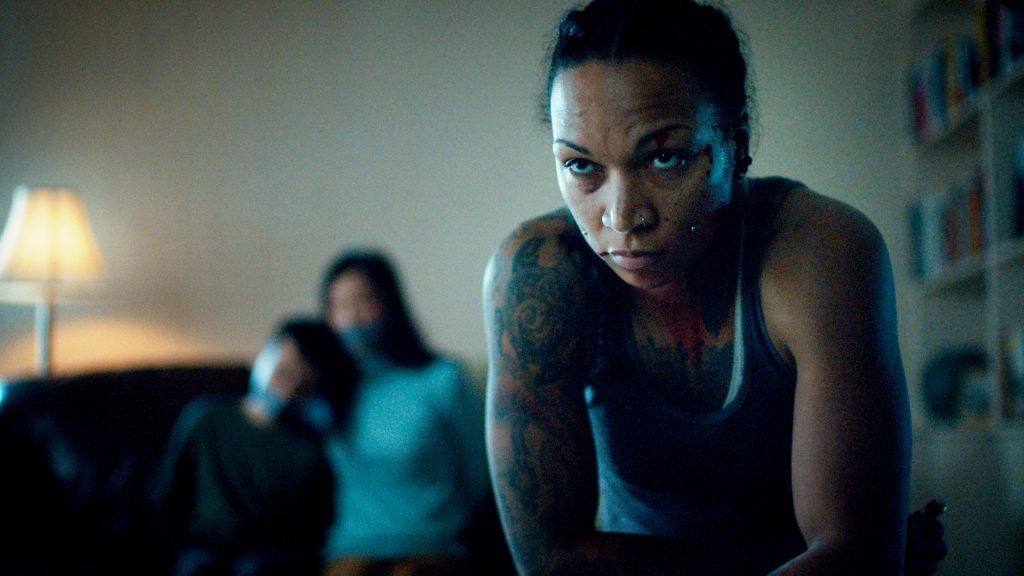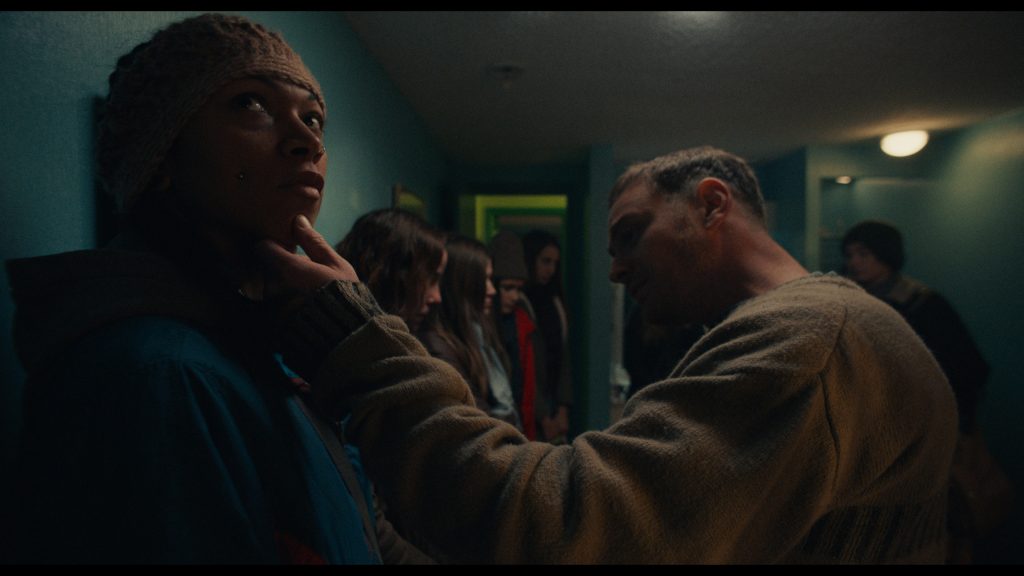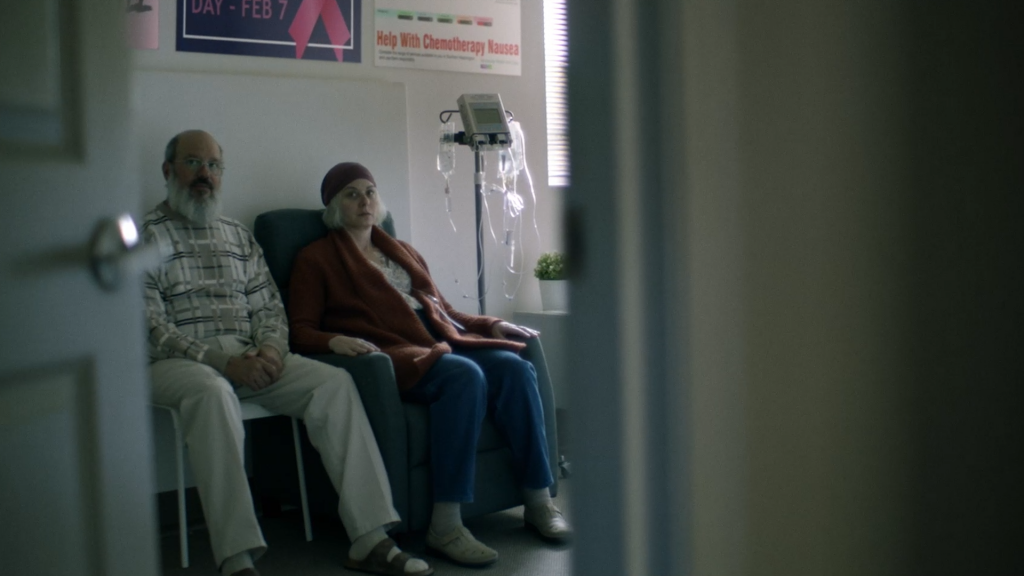September 17, 2021
by Carla Hay

Directed by Scott McGehee and David Siegel
Culture Representation: Taking place in Montana’s Paradise Valley, the drama “Montana Story” features a cast of white and Native American characters (with one black person) representing the working-class and middle-class.
Culture Clash: An estranged brother and sister have a tension-filled reunion after their father is in a coma, and the two siblings end up confronting some dark family secrets.
Culture Audience: “Montana Story” will appeal primarily to people who are interested in well-acted and realistically crafted dramas about dysfunctional families.

“Montana Story” shows in nuanced and heartbreaking ways how a rift in a family can come not just from damaging words and actions but also by what’s been left unsaid. It’s an emotionally genuine and contemplative story of a tense family reunion between a brother and a sister who have not seen and spoken to each other in seven years. The movie also touches on issues of euthanasia, controversies over pipelines running through Native American land, and the daily struggles of working-class people who are a few paychecks away from financial ruin. “Montana Story”—written and directed by Scott McGehee and David Siegel—had its world premiere at the Toronto International Film Festival.
The movie unfolds in layers to reveal the reasons why siblings Cal (played by Owen Teague) and Erin (played by Haley Lu Richardson) have been estranged for seven years. The full story of why Cal and Erin became alienated from each other comes out about halfway through the film. Cal and Erin have both reunited at the Montana ranch of their widowed attorney father Wade (played by Rob Story), who has been in a coma from a stroke and is not expected to recover. Although the movie does not name any cities where the story takes place, “Montana Story” was filmed on location in Montana’s Paradise Valley, in the cities of Bozeman, Livingston and Ringling. The movie’s cinematography (by Giles Nuttgens) of this Montana outdoor scenery is suitably breathtaking.
The ranch where Wade is bedridden in a coma is the same home where Cal and Erin grew up. Cal, who is 22, is a quiet and introverted bachelor who lives in Cheyenne, Wyoming. He’s an aspiring civil engineer who currently works for Cheyenne’s city planning department. Cal arrives at the family home first by driving there in his own car. Cal doesn’t know it yet, but Erin is about to show up for a surprise visit.
Erin, who is 25, is a feisty and stubborn bachelorette who lives in New York’s Hudson Valley. She works as a cook at a farm-to-table restaurant, and she is deeply concerned about environmental issues. Erin has traveled by airplane to go to Montana and doesn’t have a rental car. She uses a rideshare service to go to and from the airport.
It’s mentioned later in the story that Cal and Erin have two different mothers, who are both deceased. These two mothers are not shown in flashbacks but are briefly described in the movie through conversations. Erin’s mother Libby, who was Wade’s wife, died when she gave birth to Erin. Libby is described as the greatest love of Wade’s life.
Cal’s mother Connie was the nanny who took care of Erin after Libby died. Connie, who died in a car accident two years ago, is described as someone who knew that Wade didn’t love her as much as he loved Libby, but Connie loved Wade anyway. Connie and Wade never married each other, but they lived together and raised Erin and Cal.
Before Erin shows up for her surprise visit, Cal braces himself for some of the difficult but inevitable experiences of a family member who has to prepare for a loved one to die. When Cal goes inside the home, he doesn’t immediately go into the bedroom where Wade is in a coma, because it will be the first time that Cal will see his father in this condition. Instead, Cal goes into his childhood bedroom, which has been kept exactly the way he left it when he moved out of the family home to go to college in Wyoming. The way he looks around the room is the way someone might look at a mausoleum filled with long-buried memories.
When Cal does go into the room to see his father (who is hooked up to a ventilating machine), the expression on Cal’s face shows a range of emotions. It’s the look of someone who’s had a love/hate relationship with a parent and doesn’t quite know how to process that this parent is unable to communicate. How do you reconcile with someone who’s in a coma?
There are two people who have been taking care of the day-to-day duties of the household. The part-time housekeeper Valentina (played by Kimberly Guerrero) has been a longtime employee of the family. Valentina has known Erin and Cal since they were children. Wade’s home care aide, who is being paid for by state government assistance, is a Kenyan immigrant named Ace (played by Gilbert Owuor). Cal and Ace meet for the first time when Cal comes home to visit Wade, who isn’t expected to live much longer.
Valentina and Ace are very kind and compassionate. Ace tells Cal that although Wade is in a coma and cannot communicate, Wade’s brain is still functioning. It’s this piece of information that probably motivates Cal to do something in one of the more emotionally powerful scenes in the movie.
Wade used to be a financially successful attorney. But something happened (some of the details are revealed but not all) that resulted in him filing for bankruptcy before he had a stroke. It’s why all of his medical bills are being paid for by government benefits and why the family ranch (which is in Wade’s name) is going to be sold after Wade dies. Wade apparently has no other immediate relatives besides his two children.
Cal has to meet with an attorney named Don (played by played by John Ludin) to gets these matters sorted. Don tells Wade that the sale of the ranch should be enough to pay for Wade’s medical bills that would have to be paid by any heirs. Don advises Cal to sell Wade’s car, since the car is no longer of any use to Wade.
The ranch used to be thriving and had several animals, including horses. There are still a few remaining animals, such as chickens, but now there is only one horse on the property: a 25-year-old black stallion named Mr. T. Because of Mr. T’s advanced age and arthritis, it’s unlikely that anyone will buy the horse, so Cal takes Don’s advice to arrange for Mr. T to get euthanized.
When Erin arrives at the ranch, Cal is in complete shock. It’s revealed that Erin had run away from home at age 18 and cut off contact with all of her family members. Cal had tried to get in touch with her, but she eventually changed her phone number and never told anyone in her family where she was.
When she sees Cal again all these years later, Erin is cold and abrupt. She explains the only reason why she’s there is to see their father one last time before he dies. How did Erin find out about Wade being in a coma? Cal asks this question and Erin tells him. (The answer won’t be revealed in this review.)
As the two siblings spend time together in an already stressful situation, long-simmering resentments come to the surface. Viewers will notice that Erin and Cal have different ways of dealing with problems. Erin is more outspoken and determined to do what she thinks is right, even if it makes other people uncomfortable. Cal is more willing to compromise and is more likey to be a people pleaser.
It’s why Erin and Cal end up clashing over what to do about Mr. T, the family’s longtime horse. Erin is livid that Cal made plans to put down Mr. T. She’s so angry about it that she insists that she’s going to buy a truck and horse trailer and drive Mr. T all the way back to New York state with her. Of course, Erin and Cal’s arguments about the horse are just symptoms of a larger problems and traumatic family secrets, which the siblings eventually have to confront if they have a chance of healing their fractured relationship.
Although “Montana Story” is centered on Erin and Cal, the movie also brings up issues experienced by the supporting characters who are feeling the ripple effects of what will happen to them after Wade dies. Valentina has another part-time job at a retail store, which has just reduced her work hours. Based on worried conversations that Valentina has, she’s in danger of being financially ruined if she doesn’t have another job lined up in time after Wade dies.
And even though Ace is being paid by the state, he too is in a precarious financial situation because it’s unknown where he will find his next home care job. In a conversation that Ace has with Cal, Ace opens up about needing a steady job because he sends some of his income back to Kenya to help his family. It’s in these quiet moments that the movie shows how lives of working-class “gig” employees are often dangerously close to sinking them into poverty under unfortunate circumstances.
“Montana Story” also includes a brief snippet of a newscast reporting that a federal judge ordered the shutdown of the Dakota Access Pipeline. The newscast mentions that this shutdown is a victory for the Standing Rock Sioux Tribe, which opposed the pipeline because of concerns that the pipeline would cause pollution in the water and land where many of the tribe members live. It just so happens that Vivian and her family are part of this tribe, so the pipeline is another added stress in her life.
Vivian has an adult son named Joey (played by Asivak Koostachin), who’s about the same age as Erin. Because of Valentina, Joey has known Erin and Cal for several years. Joey used to work at the ranch and now works part-time for a tow truck company, but he’s also hurting for money. Joey and Cal are happy to see each other. Joey is disappointed to hear that the ranch will be sold, but he understands why the decision was made.
Joey is also delighted to see Erin because it’s obvious that he’s had a longtime crush on her, but the feeling isn’t mutual. Erin has put Joey in the “friend zone,” which he has accepted, but his hopeful demeanor is of someone who still thinks there’s a small chance that Erin might change her mind. Another tribe member named Mukki (played by Eugene Brave Rock) ends up playing an important role in Erin’s plans for Mr. T.
“Montana Story” isn’t an action-packed movie. It moves along at a pace that’s entirely realistic for rural and isolated areas. And this isn’t a melodramatic and talkative movie where people get into arguments every 10 minutes. What makes “Montana Story” better than the average family drama is how it uses moments of silence to depict unspoken hurt and regrets.
For example, there’s a scene where Cal and Erin are driving somewhere in Cal’s car. He fills her in on what his life has been like since they last saw each other. Cal seems very eager to share this information, and there’s a sense that he wants Erin’s approval. But she doesn’t say anything in response to finding out these major updates in his life. Her lack of response seems to be partly out of spite and partly because she doesn’t really know what to say. The look on Cal’s face is of someone who is crushed by his sister’s aloofness.
And that’s why Richardson and Teague are so perfectly cast for this movie, which has just the right tone and direction from writer/directors McGehee and Siegel. There are so many moments in “Montana Story” where Richardson and Teague convey emotions (and repression of emotions) with their facial expressions and body language that other actors wouldn’t be able to convey, even if they had all these feelings spelled out for them in articulate lines of dialogue. Without the admirable performances of Richardson and Teague, “Montana Story” would not be as emotionally resonant as it is.
“Montana Story” could be described as understated or low-key, compared to other dramas about family members dealing with grudges and estrangement. In addition to the siblings’ issues with each other, Cal and Erin had a very difficult relationship with their father. Those hard feelings don’t automatically disappear when someone is close to death. It’s an uncomfortable truth that “Montana Story” shows in various shades and details that don’t have a single moment of “only in a movie” phoniness.
UPDATE: Bleecker Street will release “Montana Story” in select U.S. cinemas on May 13, 2022. Sony Pictures Entertainment’s Stage 6 will release the movie outside of North America, on a date to be announced.




